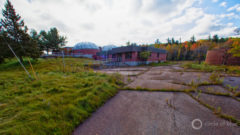Don’t panic over dead fish
As lakes thaw this spring, you might spot dead fish, experts warn.
The post Don’t panic over dead fish first appeared on Great Lakes Echo.Great Lakes Echo
http://greatlakesecho.org/2021/03/23/dont-panic-over-dead-fish/
Priority Shift: Great Lakes exec moves environmental justice to top of list
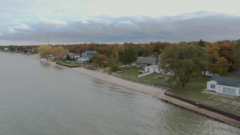
Chicago’s Joel Brammeier came of age advocating for the Great Lakes in an era when federal programs that are widely accepted today like the Great Lakes Restoration Initiative were barely on the drawing board.
Brammeier started his advocacy work in 2001 when he managed habitat programs for the Lake Michigan Federation, which later became the Alliance for the Great Lakes as its mission expanded.
Great Lakes Now
https://www.greatlakesnow.org/2021/03/great-lakes-environmental-justice-priority/
Marquette’s Presque Isle Park closes road for a month so salamanders can cross
Marquette, Michigan, is closing the lone road looping through Presque Isle Park, which sits on a peninsula jutting into Lake Superior, to help blue spotted salamanders cross. Read the full story by the Detroit Free Press.
Great Lakes Commission
https://www.glc.org/dailynews/20210322-salamander
Wreck of the Contest re-emerges from Lake Michigan near Whitehall
In Michigan, the remains of the Contest, a 124-foot schooner that grounded near White Lake in 1882, are visible again thanks to shifting beach sand and dropping Lake Michigan water levels. Read the full story by MLive.
Great Lakes Commission
https://www.glc.org/dailynews/20210322-contest
Park authorities plan four spring fires for Indiana Dunes
Authorities plan four prescribed fires at Indiana Dunes National Park this spring, totaling more than 900 acres. Read the full story by The Associated Press.
Great Lakes Commission
https://www.glc.org/dailynews/20210322-fires
Minnesota may add climate impacts to environmental review
Several state agencies are recommending significant changes to Minnesota’s environmental review program that would require proposers to add up their project’s carbon footprint — and consider ways to reduce emissions that contribute to climate change. Read the full story by Minnesota Public Radio.
Great Lakes Commission
https://www.glc.org/dailynews/20210322-climate
After leaving Isle Royale on an ice bridge, wolf made epic journey
A female wolf that was introduced to Isle Royale National Park in the fall of 2018 left the island on an ice bridge in January the following year, and it turns out, she made quite the journey. A team of federal, tribal and university researchers recently published a study detailing the wolf’s travels after she left the island. Read the full story by Minnesota Public Radio.
Great Lakes Commission
https://www.glc.org/dailynews/20210322-wolf
Fish vision genes could inform Great Lakes restoration of native, deep-water species
One species of fish in Lake Superior may have regained an ancestral adaptation that enables better vision in deep water, according to a recent study. That information could help create restoration plans for the kiyis, a fish that lives deep in the lake. Read the full story by Capital News Service.
Great Lakes Commission
https://www.glc.org/dailynews/20210322-vision
Research shows Great Lakes algae and microplastics connect
Scientists discovered plastic microfibers in the Great Lakes are sticking to green algae that grows along the bottomlands in a way that could help keep the pollution out of the environment. Read the full story by the Record Eagle.
Great Lakes Commission
https://www.glc.org/dailynews/20210322-algae-plastics
Scientists predict trouble for infrastructure in changing climate
Northeast Michigan is getting warmer, climate records show. The increase in temperature isn’t telling the whole story, though, as Michigan scientists say drastic climate swings between hot and cold and wet and dry cause issues for area farmers and existing infrastructure. Read the full story by the Alpena News.
Great Lakes Commission
https://www.glc.org/dailynews/20210322-climate
Tribal officials hopeful new Secretary of the Interior Deb Haaland can end wolf hunting in Wisconsin
Tribal officials, especially those from Ojibwe nations in northern Wisconsin, are hopeful new U.S. Secretary of the Interior Deb Haaland can help restore protections for gray wolves and stop another hunting season this fall. They are also hopeful her office will help increase funding for the Great Lakes Restoration Initiative, among other environmental concerns. Read the full story by the Green Bay Press Gazette
Great Lakes Commission
https://www.glc.org/dailynews/20210322-haaland
Soo Locks to open early: Shipping season begins this week
The U.S. Army Corps of Engineers Detroit District’s Soo Area Office will open the Poe Lock at noon Wednesday, marking the start of the 2021 Great Lakes shipping season. Read the full story by the Mining Journal.
Great Lakes Commission
https://www.glc.org/dailynews/20210322-locks
Environmental groups ask Biden to withdraw Trump review of oil drilling option in Lake Huron
Environmental groups are asking the Biden administration to close a review to cut the Thunder Bay Marine Sanctuary in Lake Huron by 90%. Read the full story by Michigan Radio.
Great Lakes Commission
https://www.glc.org/dailynews/20210322-sanctuary
Smart meters, solar panels could improve energy reliability amid climate change
Energy experts say Michigan can make its energy infrastructure more reliable against the effects of climate change by increasing the state’s energy storage capabilities and improving technologies that detect power outages.
The post Smart meters, solar panels could improve energy reliability amid climate change first appeared on Great Lakes Echo.Great Lakes Echo
http://greatlakesecho.org/2021/03/22/smart-meters-solar-panels-could-improve-energy-reliability-amid-climate-change/
Pandemic, China trash-ban push recyclers to robots
There is an emerging new worker that could make a career out of sorting recyclables: robots.
The post Pandemic, China trash-ban push recyclers to robots first appeared on Great Lakes Echo.Great Lakes Echo
http://greatlakesecho.org/2021/03/22/pandemic-china-trash-ban-push-recyclers-to-robots/
Special Weather Statement issued March 21 at 9:39AM CDT by NWS
Current Watches, Warnings and Advisories for Brown (WIC009) Wisconsin Issued by the National Weather Service
https://alerts.weather.gov/cap/wwacapget.php?x=WI12619503385C.SpecialWeatherStatement.126195104880WI.GRBSPSGRB.3b1beec81735ed3555f56adb056849d0
Special Weather Statement issued March 21 at 6:10AM CDT by NWS
Current Watches, Warnings and Advisories for Brown (WIC009) Wisconsin Issued by the National Weather Service
https://alerts.weather.gov/cap/wwacapget.php?x=WI12619502B7D8.SpecialWeatherStatement.12619503FE04WI.GRBSPSGRB.3b77a733acfe35fc01f412b80021d336
Special Weather Statement issued March 20 at 10:39AM CDT by NWS
Current Watches, Warnings and Advisories for Brown (WIC009) Wisconsin Issued by the National Weather Service
https://alerts.weather.gov/cap/wwacapget.php?x=WI126194F41D2C.SpecialWeatherStatement.126195010640WI.GRBSPSGRB.3b77a733acfe35fc01f412b80021d336
Special Weather Statement issued March 20 at 5:17AM CDT by NWS
Current Watches, Warnings and Advisories for Brown (WIC009) Wisconsin Issued by the National Weather Service
https://alerts.weather.gov/cap/wwacapget.php?x=WI126194F35144.SpecialWeatherStatement.126194F48ED8WI.GRBSPSGRB.3b77a733acfe35fc01f412b80021d336
Special Weather Statement issued March 19 at 10:00PM CDT by NWS
Current Watches, Warnings and Advisories for Brown (WIC009) Wisconsin Issued by the National Weather Service
https://alerts.weather.gov/cap/wwacapget.php?x=WI126194F23930.SpecialWeatherStatement.126194F371B0WI.GRBSPSGRB.3b77a733acfe35fc01f412b80021d336
Freshwater Weekly: March 19, 2021
March 19, 2021
This week: Helping Others Make a Difference: Board Spotlight + Michigan Residents Outraged by 8-month Disclosure Gap on PFAS + New York Legislature Moving Budget Bills for COVID Recovery, But Excludes Water Shut-Off Protections +Flint Water Crisis Update–Attorneys Want Large Percentage of Settlement Fees + World Water Day
Helping Others Make a Difference: Board Spotlight, Karen Reinbold
Freshwater Future board member, Karen Reinbold’s experience with community environmental activism at a young age was a powerful influence. Her mother demonstrated that protecting our waters is something we can’t take for granted or leave to others. This lesson ultimately helped connect Karen to Freshwater Future. Karen shares here how she was able to take action in her community and help Freshwater Future help communities around the Great Lakes.
Michigan Residents Outraged by 8-month Disclosure Gap on PFAS Contamination
Michigan residents and members of a citizens advisory group criticized state officials about taking 8-months to notify residents of an investigation of the toxic chemicals called PFAS near an airport, putting residents’ health at risk. The state had test results showing contamination and had informed airport officials but did not inform residents near the contamination for 8 months. Changes should be made immediately to the state’s outreach protocols to improve disclosure and transparency before and during environmental contamination investigations. Stay tuned for future opportunities to inform officials about PFAS contamination in Michigan.
New York Legislature Moving Budget Bills for COVID Recovery, But Excludes Water Shut-Off Protections
New York Senate’s budget proposal includes substantial funding for rental and homeowner assistance; the arts; education; businesses, including minority and women owned small businesses; and a provision for the creation of a $3 billion Clean Water, Green Jobs, and Green New York bond to be voted on in November, 2021. This bond would provide critical funding for the preservation, enhancement, and restoration of New York’s natural resources while reducing the impacts of climate change. Missing from both the Assembly and the Senate’s versions of the budget bill is the Governor’s proposed water shutoff moratorium language when there is a state of emergency.
Flint Water Crisis Update: Attorneys Want Large Percentage of Settlement Fees
Attorneys involved in the Flint Water Crisis civil lawsuit settlement filed for 32% of the total settlement to cover their fees, which is approximately $210 million. The majority of the settlement is designated for the children who were poisoned during the switch of the city’s public water source. The federal judge will decide what percentage of the settlement will be subject to attorney fees. Freshwater Future praises the lawyers for the assistance in doing what’s right and urges them to continue to do so by allowing more dollars to flow to the residents.
Deadline Approaching–Freshwater Future Project Grant Applications Due March 31, 2021
Call us today to learn more, 231-348-8200.
Blog – Freshwater Future
https://freshwaterfuture.org/freshwater-weekly/freshwater-weekly-march-19-2021/
A “River of Poems” spans the world
We expected only a few local poets would be interested. We thought they’d offer poems about the St. Louis River. That was our mindset when the River Talk planning team first developed the theme for the public poetry reading to be held in conjunction with the St. Louis River Summit as an evening program in March. We were mistaken, but in the best possible way.
 In reality, our call for river poems through the literary submission management platform Submittable garnered interest from 76 poets from across the U.S. and around the world. They submitted 148 poems for consideration.
In reality, our call for river poems through the literary submission management platform Submittable garnered interest from 76 poets from across the U.S. and around the world. They submitted 148 poems for consideration.
“As it turns out, a lot of people like to write about rivers. That’s because they are really important in our communities and in our lives,” said Deanna Erickson, director of the National Lake Superior Estuarine Research Reserve, which co-sponsors the River Talk series with Wisconsin Sea Grant.
We quickly realized we were going to need more judges. In the end, we gathered six who represented a good cross-section of the audience we expected to attend the summit.
We’d like to thank judges Hannah Ramage, monitoring coordinator with the Lake Superior Reserve; Julie O’Leary, director of the University of Superior’s (UWS) Undergraduate Research, Scholarship and Creative Activity Program; Kari Jacobson-Hedin, watershed specialist with the Fond du Lac Tribe; Nick Danz, dean of academic affairs for UWS; Russ Maron, poetry appreciator; and myself (Marie Zhuikov), a poet and a science communicator for Wisconsin Sea Grant.
The judging was “blind,” which means the poets’ names were not associated with their poems. After two rounds, the judges narrowed the number of poems down to a dozen, with a few for backup in case any of the chosen poets could not be reached.
Although communication was sometimes a challenge, all 12 poets were enthusiastic about participating in the reading. They represented a wide diversity of ages and ethnicities.
The River Talk was several days ago, but the warm fuzzy feelings it engendered remain with me. I could use many adjectives to describe it: powerful, beautiful, stark, raw, funny — but it’s really best if you listen to the poems and feel all the feels for yourselves. The reading drew 85 Zoomers, a record attendance.
The Lake Superior Reserve, our partner in the talks, recorded the reading and it’s available on their YouTube channel. Here’s a list of the poets (in the order they read) and the names of their poems:
Tyler Dettloff (Michigan) “My Stars”
Heather Dobbins (Arkansas) “I Held us on for 36 Hours after the Levee Broke to hell”
Ben Green (New Mexico) “Immersion: A Prayer of Intent”
Lorraine Lamey (Michigan) “Catching Your Drift”
Joan Macintosh (Newfoundland) “The Current Feels”
Kate Meyer-Currey (England) “Timberscombe”
Rebecca Nelson (California) “Of the St. Louis River”
Stephanie Niu (New York) “To the Beaver’s Eyes”
Diana Randolph (Wisconsin) “Knowing the Way”
Ron Riekki (Florida) “It Took a Long Time to Discover”
Derold Sligh (South Korea) “Rouge River”
Lucy Tyrrell (Wisconsin) “Talking Water”
Ironically, the one poem specifically about the St. Louis River was written by someone who had never visited it. Rebecca Nelson said her poem, “Of the St. Louis River” was inspired by the spiritual experiences she’s had while watching water. She grew up in the Midwest and said she wrote the poem thinking of the rivers she knew from childhood. “I would love to visit sometime after the pandemic!” Nelson said.
Barb Huberty, St. Louis River Area of Concern coordinator for the Minnesota Pollution Control Agency, offered this comment in the Zoom chat, “I never knew that poetry could unite people across the globe.”
Sharon Moen, Eat Wisconsin Fish outreach specialist for Wisconsin Sea Grant, offered, “Thank you to all the poets and organizers! I am inspired by the depth of your thoughts and stories.”
Remaining River Talks will be held on April 14 and May 12. For more information, visit the River Talks page: go.wisc.edu/4uz720.
The post A “River of Poems” spans the world first appeared on Wisconsin Sea Grant.
Blog – Wisconsin Sea Grant
https://www.seagrant.wisc.edu/blog/a-river-of-poems-spans-the-world/
Special Weather Statement issued March 19 at 12:46PM CDT by NWS
Current Watches, Warnings and Advisories for Brown (WIC009) Wisconsin Issued by the National Weather Service
https://alerts.weather.gov/cap/wwacapget.php?x=WI126194E52BC8.SpecialWeatherStatement.126194F1EB10WI.GRBSPSGRB.3b77a733acfe35fc01f412b80021d336
US Army Corps suspends PolyMet permit as EPA reviews whether proposed mine ‘may affect’ Fond du Lac Band
The U.S. Army Corps of Engineers suspended a wetlands permit for PolyMet, the company trying to open Minnesota’s first copper-nickel mine, as the Environmental Protection Agency reviews whether the proposed project “may affect” the downstream Fond du Lac Band of Lake Superior Chippewa. Read the full story by the Duluth News Tribune.
Great Lakes Commission
https://www.glc.org/dailynews/20210319-polymetmine
MPCA rings alarm: Old landfills leaking contaminants in Northland, across state
Six closed and capped landfills in St. Louis County, along with scores of others across the state, are emitting “forever chemical” contaminants in excess of state health guidelines, the Minnesota Pollution Control Agency announced Thursday. Groundwater at 97% of the state’s closed landfills, 98 of 101, shows the contamination — some 10 times the health guidelines. Read the full story by the Pine Journal.
Great Lakes Commission
https://www.glc.org/dailynews/20210319-landfills
Wolverine ‘phyto’ PFAS cleanup plan similar to doing nothing, says expert
An environmental chemistry expert and others on a citizen advisory panel are not impressed with Wolverine World Wide’s plan to clean up its toxic tannery waste dump in Kent County, Michigan, by relying primarily on planting trees over the contamination. Read the full story by MLive.
Great Lakes Commission
https://www.glc.org/dailynews/20210319-wolverine
Army Corps report focuses on Old Fort Niagara shoreline protection
In New York, the U.S. Army Corps of Engineers, Buffalo District, released a 735-page report of the federal government’s response to Lake Ontario shoreline erosion, which threatens historically significant structures at Old Fort Niagara. Read the full story by Niagara Frontier Publications.
Great Lakes Commission
https://www.glc.org/dailynews/20210319-niagara
EDITORIAL: Legislators rejected proposed changes, but the Erie Canal’s problems remain
The future of New York’s Erie Canal presents legitimate challenges that need to be addressed. Giving the canal a new name is not high on the list. Protecting it, and the Great Lakes, from invasive species is. Read the full story by The Buffalo News.
Great Lakes Commission
https://www.glc.org/dailynews/20210319-canal
Duluth Port Authority moves back to the waterfront with new HQ
After more than two years landlocked in the city’s Lincoln Park neighborhood, the Duluth Seaway Port Authority returned to the Lake Superior waterfront to a new headquarters just in time for the kickoff of the 2021 shipping season. Read the full story by the Star Tribune.
Great Lakes Commission
https://www.glc.org/dailynews/20210319-waterfronthq
Beach flood barriers staying put through summer in South Haven
In South Haven, Michigan, an 836 ft. line of flood mitigation barriers installed in 2020 will stay put, in order to prevent lakeshore flooding from jeopardizing the water treatment facility’s underground infrastructure. Read the full story by WWMT-TV – South Haven, MI.
Great Lakes Commission
https://www.glc.org/dailynews/20210319-barriers
New animal tracking system now online at Belle Isle
Through a coordinated effort by the Belle Isle Nature Center and the Detroit Zoo, a new wildlife tracking system has been installed that will help researchers learn more about the wildlife of the Great Lakes. Read the full story by C&G Newspapers.
Great Lakes Commission
https://www.glc.org/dailynews/20210319-animaltracks
H2Ohio: Agency directors focus on wetlands, farmer subsidies, replacing lead lines
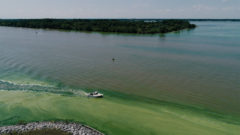
The first full-year report for Ohio Gov. Mike DeWine’s much-publicized H2Ohio water quality initiative is out.
Introduced in 2019, the plan has already reaped benefits for Ohio residents and will continue to expand in its scope, according to officials charged with its implementation.
The report was offered in a web presentation by Ohio Department of Agriculture Director Dorothy Pelanda, Ohio Department of Natural Resources Director Mary Mertz and Ohio Environmental Protection Agency Director Laurie Stevenson.
Great Lakes Now
https://www.greatlakesnow.org/2021/03/h2ohio-agency-directors-wetlands-lead-agriculture/
Save Water, Save Nature: Kids calendar art contest promotes healthy water management
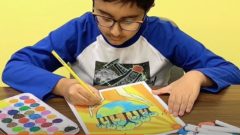
Hundreds of artistic entries from 4th and 5th grade students came in for this year’s Oakland County Water Resources Commissioner’s Kids Clean Water Calendar Contest, and Great Lakes Now Host Ward Detwiler had to decide which drawings would be printed for each month.
“Fortunately, because I’d done this last year, I knew how hard it was going to be,” Detwiler said.
Great Lakes Now
https://www.greatlakesnow.org/2021/03/kids-calendar-art-contest-healthy-water-management/
Board Spotlight – Karen Reinbold
Helping Others Make a Difference.
I grew up on the Great South Bay on Long Island, New York, surrounded by beautiful wetlands. I still have memories of the bullrushes swaying in the ocean breeze on warm summer evenings. My family never took the area wetlands for granted, though; I knew how fragile they were even as a young child. My mother fought hard to protect a creek that ran behind our house by forming an association to fight against development that would have destroyed its wetlands. We won, and the land is still there.
In 2015, when a friend of mine told me about Freshwater Future, I had already been living along Lake Michigan for almost 15 years. While I hadn’t been part of the Great Lakes environmental community before, I was immediately drawn to the mission of protecting these important resources.
I was able to apply my non-profit accounting and management skills to help Freshwater Future improve its financial management practices. As I learned more about the organization, I realized we shared a passion – helping others expand their impact. That’s what Freshwater Future does.
When I hear about the local groups that Freshwater Future has supported, I think about how important that work is – helping people who are trying to make a difference but may not have the skills or resources to do it. It helps people like my mom and so many other grassroots groups realize their conservation goals.
Recently, my community faced a similar threat to local wetlands; one that still hangs in the balance. I’m proud to say my family fought to protect the land – starting a petition, providing testimony, making signs and protesting. As inspiration, I drew on the work my mom did and the work Freshwater Future and its partner organizations do every day.
Many of us take water for granted. We have that luxury because of groups like Freshwater Future that are fighting on our behalf to keep water clean and accessible to all.
As I approach the end of my term on the board this spring, I’ve been thinking about how much I’ve enjoyed getting to know the board and staff, and how much they’ve taught me over the past 6 years. Thank you to all of you.
Karen Reinbold is the Health and Science Director at American Medical Association and lives and works in the Chicago area.
Blog – Freshwater Future
https://freshwaterfuture.org/news/board-spotlight-karen-reinbold/
Free Indiana nature passports reward outdoor adventurers
Indiana's program was inspired by a similar successful passport program in Iowa.
The post Free Indiana nature passports reward outdoor adventurers first appeared on Great Lakes Echo.Great Lakes Echo
http://greatlakesecho.org/2021/03/19/free-indiana-nature-passports-reward-outdoor-adventurers/
Wisconsin Legislature moves to kill limits on PFAS, protect conversion therapy
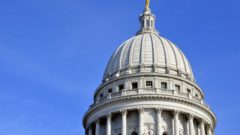
By Todd Richmond, Associated Press Writer
MADISON, Wis. (AP) — The Wisconsin Legislature moved Tuesday to kill limits on PFAS pollution and to allow therapists, counselors and social workers to continue to try to change gay and transgender people’s sexual orientation.
The Senate and Assembly both took up a bill blocking a state Department of Safety and Professional Standards rule that would have prohibited so-called conversion therapy.
Great Lakes Now
https://www.greatlakesnow.org/2021/03/ap-wisconsin-legislature-moves-to-kill-limits-on-pfas-protect-conversion-therapy/
Shifting sand, water again reveal shipwreck from 1880s
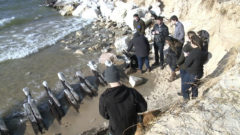
WHITEHALL, Mich. (AP) — A change in Lake Michigan water levels has revealed a shipwreck from the 1880s that is visible in western Michigan for the first time since 2018.
Experts believe it’s the wooden spine of the Contest, said Craig Rich, director of the Michigan Shipwreck Research Association.
Great Lakes Now
https://www.greatlakesnow.org/2021/03/ap-shifting-sand-water-shipwreck-1880s/
Every person is a decision maker
Vicky Harris has always loved biology—at least since 5th grade — and she’s an eternal optimist. Now retired from her position as Wisconsin Sea Grant’s water quality specialist in Green Bay, Harris reflects on her 50-year on-again off-again relationship with Sea Grant, and ponders the fate of the entire planet.
Harris’ relationship with Sea Grant started with a college class in oceanography taught by Professor John Pezzetta at the University of Wisconsin-Green Bay. She had transferred from UW-Madison as a premed student after the student protests against the Vietnam War had closed the UW campus and the Sterling Hall bombing raised doubts about the next semester.
Pezzetta had Sea Grant-funded research on the sediments surrounding two nuclear power plant water intakes near Two Rivers and Kewaunee and needed a research assistant to collect samples and analyze them back in the lab. Harris enjoyed the experience and continued to work with Pezzetta as he moved on to another project studying sediments around the coal-fired power plant in Green Bay.
As a graduate student, she worked with the U.S. Fish and Wildlife Service studying Green Bay waterfowl and macroinvertebrate populations and reviewing wetland permits.
In 1978, Sea Grant created a position for a field agent in Green Bay, and Harris was ready.
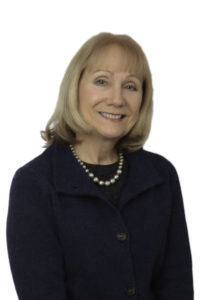
Vicky Harris had taken on multiple leadership roles as an advocate for the Lower Fox River, Green Bay and Lake Michigan.
“Sea Grant really was a key factor in my choosing Great Lakes management as a career to begin with, so going to work for them was wonderful,” she said. “The Green Bay field office was created by Sea Grant to develop an ecosystem-based research and outreach program for the bay, which was so polluted. I loved being part of developing a new ecosystem approach and learned so much from the researchers.”
However, at the time Harris was most interested in being a field biologist studying birds and wetlands, and she felt that working for a regulatory organization — an agency that had “power” — would have the most impact. So, she returned to the U.S. Fish and Wildlife Service in 1980 only to lose her job when Ronald Reagan was elected president and the new administration swept in with huge cuts to government agency budgets and staffing. From there she ended up working as the Northeast Wisconsin water resource planner and policy analyst at the Wisconsin Department of Natural Resources (DNR) — a position she would keep for about 17 years.
It was during this time that she began her involvement with several of the key projects that define her career, projects that she is still involved with even after her retirement in 2011.
Two of these projects are the Green Bay and Fox River Remedial Action Plan (RAP) and the Cat Island Restoration project. The RAP was created in the 1980s by the DNR, and Harris served as the onsite coordinator. She enlisted the involvement of researchers and community stakeholders to address the issues of contaminated sediment, poor water quality and lost or altered habitat in Green Bay. The Cat Island project evolved from the RAP and involves rebuilding a chain of barrier islands in southern Green Bay using dredged material to provide habitat while also providing a beneficial use for the dredged material.
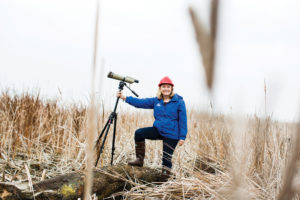
Harris was instrumental to the kickoff of the restoration of the Cat Islands and still serves on an advisory committee. Photo by Narayan Mahon.
When a position finally opened up at Sea Grant again, Harris jumped at the chance. “It’s the best decision I’ve ever made in my career,” she said. Sea Grant is clearly not a regulatory agency, so what made Harris want to leave the position she initially thought would be the most influential?
She explained, “I think I learned over time that research — having the facts — is absolutely necessary. And it was my work with stakeholders during the development and implementation of the remedial action plan that showed that outreach was as important — that research and outreach together were in fact the key factors and not necessarily regulatory authority. Authority only goes so far.”
Harris continues to work as a member of a couple of committees advising the RAP on its future activities. “I’ve been a lifelong committee participant, I guess. I’m going from the coordinator to just one of the masses, and I still like it…I am committed to it. That, I would say, has been a real passion for me,” she said.
She also remains active on the Cat Island project as a member of its advisory committee, which continues to meet regularly.
Continued Commitment
With Sea Grant, Harris also continues to keep a hand in. She serves as a member of the Committee on Outreach and Education that provides insights and guidance on communications, education and outreach initiatives of the program.
Yet another project that benefits from Harris’ continued involvement is the Clean Marina Program, which she developed in conjunction with the Wisconsin Marine Association in 2009. The program is designed to reduce pollution from marinas into Wisconsin’s waterways. To become certified, marinas agree to adopt a set of best-management practices. Program staff conduct site visits to verify marina practices and provide training and technical support to managers.
After her retirement from Sea Grant, Harris continued to work with the Wisconsin Marine Association and current Sea Grant Water Quality Specialist Julia Noordyk for a few hours a week, but limited funding kept the program from expanding. Then in 2019 Noordyk secured a $200,000 grant from the Fund for Lake Michigan and hired Theresa Qualls as the Clean Marina Program coordinator and which had an eye toward significant expansion in 2020.
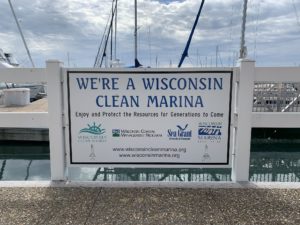
“The marinas certainly appreciate it here in Wisconsin, and everyone sees it as a win-win program. For very little investment really it’s very helpful for the marinas.” Photo by Mari Mitchell.
Unfortunately, COVID-19 is preventing travel and in-person work with the marinas, but new marinas are still joining the program. Harris is a member of the Clean Marina Technical Advisory Committee, and she remains very pleased with the project: “The marinas certainly appreciate it here in Wisconsin, and everyone sees it as a win-win program. For very little investment really it’s very helpful for the marinas.”
The Clean Marina project remains fluid, but the State of the Bay report stands tall as a comprehensive record in time about the state of Green Bay as an ecosystem. It’s the third iteration of the report, and by far the most comprehensive, including data on water quality, fish and wildlife populations, aquatic invasive species, beach conditions and contaminants.
Harris hired Theresa Qualls and together they spent years working on the report along with Vicky’s husband, Hallett J. “Bud” Harris, emeritus professor of natural and applied sciences at UW-Green Bay. Bud authored the first two State of the Bay reports, but with guidance and editing from Vicky and Bud, Qualls did the hard work of pulling the expanded report together.
“Theresa is amazing at organizing and presenting data, and I’m so glad she is continuing her work with Sea Grant,” Harris said.
Together the Harrises were crucial to Sea Grant’s work in Green Bay for decades, with Bud Harris beginning his work in the late 1960s. In February, they received the Wisconsin Sea Grant Actionable Science Award as a team for their devotion to the cleanup of the Lower Fox River and Green Bay.
Challenges and Hope
Looking into the future for Green Bay, Harris sees significant challenges — “I’ve always been an eternal optimist, but I tell you the past four years have been pretty hard to remain optimistic.”
One of the biggest problems she’s seeing is the continual rise in population, both worldwide and locally. “We keep battling for the improvement of Green Bay and yet with all the progress that’s been made in cutting back on factory discharges and sewage discharges and even the nonpoint source agricultural runoff, we’re still not making headway because we have twice as many cows now in the watershed and twice as many people,” she said.
Another problem that concerns Harris is the level of public trust placed in scientists, and even science itself. Starting with the issue of fossil fuels and climate change and continuing through other issues, there have been increasing challenges to the concept of unbiased scientists and even uncontested facts. In the complex world of environmental management, it’s important to have mangers and stakeholders working together, and stakeholder support is crucial.
“People are reluctant to change their ways. If we take more actions to reduce our carbon emissions, we can perhaps over time back off from disaster. In the meantime climate change is causing serious damages to agriculture and species on the planet. Maybe the planet will = recover in some way. It will be different,” she continued.
But Harris is an optimist, and she believes in people: “I’d have to say that when it comes down to an individual citizen, the people that I talk with and the people that live in my community, I remain optimistic. When you really talk to people about what they believe in and what they value in their life, the environment is still important, clean water is important, clean air is important. They value our Great Lakes.”
The post Every person is a decision maker first appeared on Wisconsin Sea Grant.
News Releases – Wisconsin Sea Grant
News Releases – Wisconsin Sea Grant
https://www.seagrant.wisc.edu/news/every-person-is-a-decision-maker/
People are destroying Great Lakes erosion barriers
Many people may be unknowingly creating a bigger erosion problem in the Great Lakes by removing rocks from the shoreline. Read the full story by WKFR – Kalamazoo, MI.
Great Lakes Commission
https://www.glc.org/dailynews/20210318-erosion
Ducks Unlimited launches $2.1 million research project to examine Great Lakes harmful algal blooms, mallard populations
Ducks Unlimited, a nonprofit dedicated to conserving North America’s waterfowl habitats, is launching the $2.1 million research study to reduce harmful algal blooms, improve water quality and enhance the population of mallards, an important waterfowl for the region. Read the full story by The Plain Dealer.
Great Lakes Commission
https://www.glc.org/dailynews/20210318-ducks-unlimited
A new study of Lake Michigan reveals how a shortened winter is warming its deepest waters
A unique data set out of Lake Michigan is offering a glimpse into the future of seasons in the Great Lakes and the cascading effects that global warming is having on the region’s climate. Read the full story by WJBK – TV – Detroit, MI.
Great Lakes Commission
https://www.glc.org/dailynews/20210318-lake-michigan-study
Milwaukee Clipper calls ‘All Aboard’, volunteers needed to renovate historic passenger steamer
For 24 years, the Milwaukee Clipper ship has been docked on Muskegon Lake in Muskegon, Michigan. A local group wants to breathe life back into the 117-year-old ship. Read and view the full story by WZZM – TV – Grand Rapids, MI.
Great Lakes Commission
https://www.glc.org/dailynews/20210318-milwaukee-clipper
Milwaukee Clipper calls ‘All Aboard’, volunteers needed to renovate historic passenger steamer
For 24 years, the Milwaukee Clipper ship has been docked on Muskegon Lake in Muskegon, Michigan. A local group wants to breathe life back into the 117-year-old ship. Read and view the full story by WZZM – TV – Grand Rapids, MI.
Great Lakes Commission
https://www.glc.org/dailynews/20210318-milwaukee-clipper
Salamander crossing established at Marquette’s Presque Isle Park
The City of Marquette, Michigan is closing off a quarter-mile portion of Presque Isle Park roadway to vehicles over the next month to save lives. Read the full story by WNMU – Marquette, MI.
Great Lakes Commission
https://www.glc.org/dailynews/20210318-salamander-crossing
Marathon plans to reap the benefits from palladium, copper mine
A proposed open-pit mine on the outskirts of Marathon, Ontario, a north shore community of 3,300, could attract as many as 2,000 more residents and workers over the next two to three years. Read the full story by Northern Ontario Business.
Great Lakes Commission
https://www.glc.org/dailynews/20210318-marathon-mine
Shifting sand, water again reveal shipwreck from 1880s
A change in Lake Michigan water levels has revealed a shipwreck from the 1880s that is visible in western Michigan for the first time since 2018. Read the full story by The Associated Press.
Great Lakes Commission
https://www.glc.org/dailynews/20210318-shipwreck
Lake Michigan drops, letting boat launches and roads reopen
After two seasons of unusable roadways and boat launches, the city of Grand Haven, Michigan is hoping that the past two years of planning will help it be more prepared if lake levels rise again soon. Read and view the full story by WOOD -TV – Grand Rapids, MI.
Great Lakes Commission
https://www.glc.org/dailynews/20210318-lake-michigan-water
Lake Ontario water levels bring flood risk to near-zero
Lake Ontario water levels continue to drop and are currently running near a foot below average. The risk of significant flooding is near zero for Lake Ontario and that is welcome news for those that had damage from the flooding over the past few years. Read and view the full story by WROC -TV – Rochester, NY.
Great Lakes Commission
https://www.glc.org/dailynews/20210318-ontario-water-levels
Detroit River Coalition to host joint Earth Week activities, April 17 -24
Despite the border restrictions during the pandemic, Americans and Canadians who are part of the Detroit River Coalition will be working together during a week-long celebration and cleanup of the Detroit River, April 17-24. Read the full story by The Macomb Daily.
Great Lakes Commission
https://www.glc.org/dailynews/20210318-earth-week

